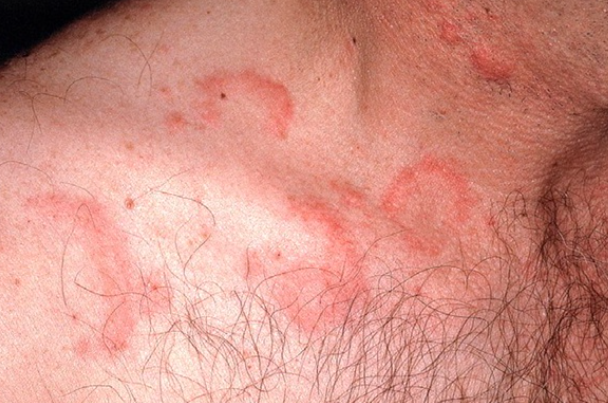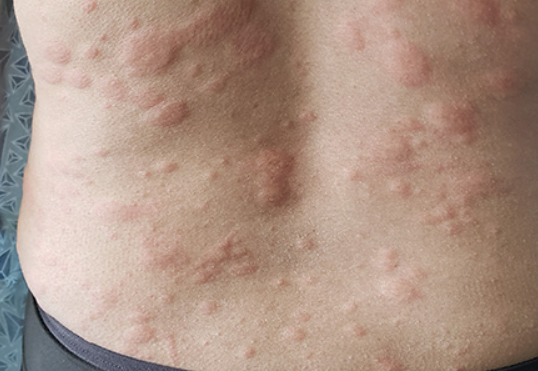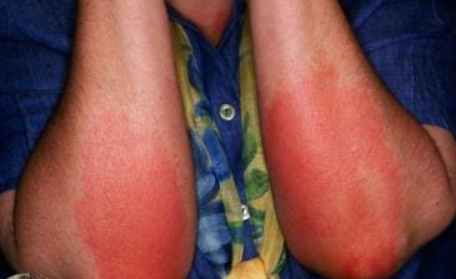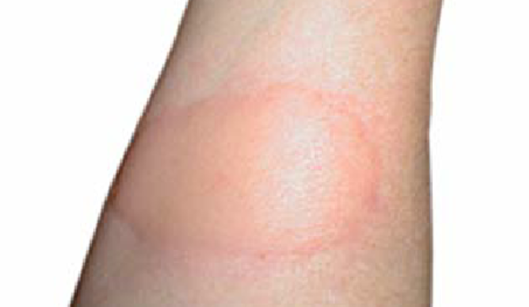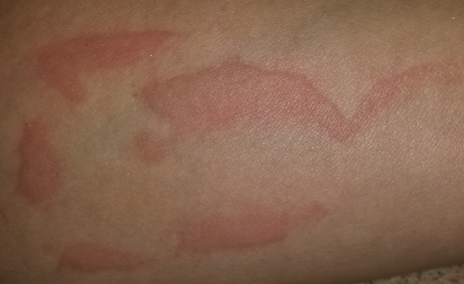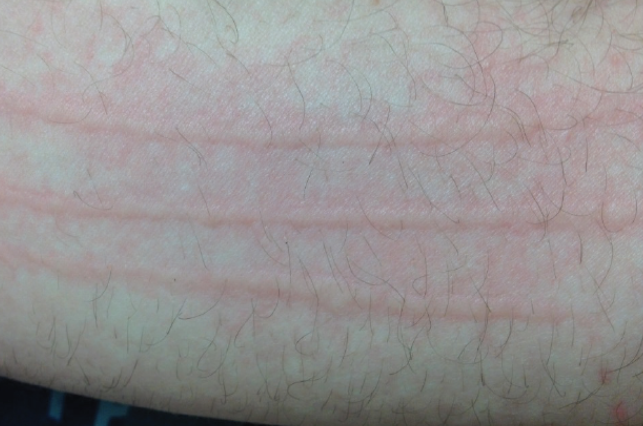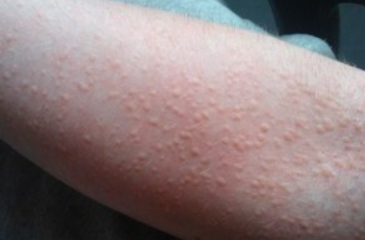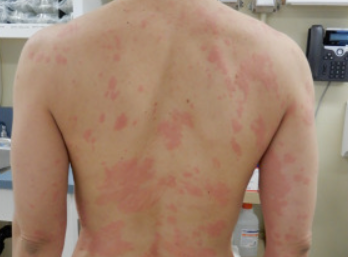Urticaria - a group of disorders characterized by the development of wheals and/or angioedema. ICD-10 code: L50.
Urticaria is a common disease: different clinical variants are diagnosed in 15-25% of the population, with chronic urticaria accounting for a quarter of cases. The duration of the disease in adults averages from 3 to 5 years, and every fifth patient with chronic urticaria experiences the appearance of wheals for a more prolonged period (up to 20 years). Additionally, every second patient with urticaria experiences the potentially life-threatening condition of angioedema.
The appearance of urticaria can be triggered by the use of various medications (aspirin and other non-steroidal anti-inflammatory drugs, angiotensin-converting enzyme inhibitors, antibiotics, etc.), certain foods (citrus fruits, chocolate, nuts, eggs, etc.), and food additives (glutamates, dyes, stabilizers, preservatives).
The development of chronic urticaria may be caused by various infectious diseases. A number of associated diseases and conditions can also lead to the appearance of urticarial eruptions, including chronic gastrointestinal diseases, endocrine pathology, oncological diseases, connective tissue diseases, cryoglobulinemia, menopause.
In some cases, the appearance of hives is triggered by physical stimulation (high and low temperatures, friction, changes in pressure, etc.) and various substances (household dust, animal hair, plant pollen, etc.).
Classification:
- L50 Urticaria
- L50.0 Allergic
- L50.1 Idiopathic
- L50.2 Caused by low or high temperatures
- L50.3 Dermographic
- L50.4 Vibratory
- L50.5 Cholinergic
- L50.6 Contact
- L50.8 Other
- L50.9 Unspecified
Currently, the etiologic classification of urticaria is not used, as a single patient may have several types or subtypes of urticaria. However, it is necessary to identify the cause of the disease, because its elimination can lead to the cure of the disease in some cases. Urticaria is divided into types and subtypes according to the duration of the disease and the aetiological factor:
Spontaneous:
- Acute (up to 6 weeks)
- Chronic (over 6 weeks)
Physical:
- Cold-induced urticaria (cold urticaria);
- Pressure-induced urticaria (delayed pressure urticaria);
- Heat-induced urticaria (heat urticaria);
- Symptomatic dermographism (urticarial dermographism, dermographic urticaria);
- Solar urticaria;
- Vibratory angioedema (vibratory urticaria / angioedema).
Other types of urticaria:
- Aquagenic urticaria
- Cholinergic urticaria
- Contact urticaria
- Adrenergic urticaria
- Paraneoplastic urticaria
Spontaneous (idiopathic) urticaria
Spontaneous (idiopathic) urticaria is the most common clinical subtype of urticaria. It is clinically manifested by wheals without characteristic localization, accompanied by itching, less often burning. The wheals may tend to merge in areas of greatest friction due to clothing or rubbing of body parts (buttocks, lumbar region, shoulders, thighs). On the face, the lesions may be almost flush with the skin's surface. In some cases, the eruptions can cover nearly the entire skin surface and may be accompanied by an increase in body temperature. The wheals initially have a pale pink color due to local dilation of the superficial network of blood vessels in the dermis (urticaria rubra), and then may take on a porcelain white color as edema builds up in the connective tissue and compresses the small vessel network (urticaria alba, seu porcellanea). As the edema subsides, the wheals gradually turn pink and then disappear without a trace.
Thus, the following characteristics are typical for a wheal in urticaria:
- Acute (up to 6 weeks)
- Chronic (over 6 weeks)
Urticaria is divided into acute and chronic forms.
Acute urticaria refers to the sudden, one-time appearance of wheals (each element lasts no more than 24 hours) with a duration of less than 6 weeks, caused by the influence of one of the triggering factors.
Chronic urticaria is a condition due to known and unknown causes in which wheals occur daily or almost daily for more than 6 weeks and each wheal lasts no longer than 24 hours. Chronic urticaria is further subdivided into recurrent and persistent, which are characterized by the constant occurrence of urticaria.Pressure urticaria
Pressure urticaria is characterized by painful infiltrates that appear 3-12 hours after pressure is applied to the skin. This type of urticaria rarely occurs on the face; it is more common on the legs after prolonged walking, on the buttocks after prolonged sitting, on the shoulders and waist from pressure from belts or straps, and on the hands from work-related activities.
A characteristic feature of pressure urticaria is the presence of a latent period of about 24 hours before the appearance of the infiltrates. The eruptions may be accompanied by arthralgia, fever, chills, and leukocytosis. Pressure urticaria may be associated with other types of physical urticaria.Heat urticaria
Cold urticaria
Dermographism
Dermographism is characterized by the local appearance of wheals within seconds or minutes after mechanical irritation of the skin. Dermographism occurs in 2-5% of the population and may develop spontaneously after drug-induced urticaria and persist for several months. It may also be associated with the use of certain H2-blockers, sometimes in combination with hypo- or hyperthyroidism, infectious diseases, diabetes mellitus, and menopause. Dermographism may cause localized or generalized pruritus of the skin.
In delayed dermographism, wheals appear 3-4 hours after skin friction (immediate reaction may or may not occur) and persist for 24-48 hours.Cholinergic Urticaria
This is a relatively rare form of the disease (5% of all urticaria cases). Triggers include exposure to high temperatures (hot weather, hot baths, hot showers), physical exertion, emotional excitement, and consumption of spicy or hot foods. The condition can recur, and most patients report exacerbations during the winter months.
Clinically, cholinergic urticaria presents in an episodic manner: the patient suddenly experiences itching, small urticarial lesions (1-3 mm in diameter) appear, and there's increased sweating. In severe cases, an asthmatic attack may occur. The episode typically lasts from a few minutes to several hours. In cases of recurrent urticaria, the next episode may not occur for at least 24 hours.
Many patients, knowing the periodicity of the disease, deliberately induce an episode of urticaria before various important events in order to avoid an outbreak in a crucial situation. There are also documented cases of coexistence of cholinergic and chronic recurrent urticaria.Contact Urticaria
Contact urticaria develops within 30-60 minutes of skin contact with certain substances. The direct action of these substances on the skin may result in wheals in a limited area, generalized urticaria, or urticaria in combination with an anaphylactic reaction. There are both non-immune (non-allergic) and immune (allergic) forms of contact urticaria.
Nonimmune contact urticaria. The nonimmune form of contact urticaria is the most common and is usually mild. Histamine-releasing substances are produced by certain plants (e.g., nettles) and living organisms (e.g., caterpillars, jellyfish). Some chemical compounds, such as dimethyl sulfoxide, cobalt chloride, benzoic acid, cinnamaldehyde, and others, also have histamine-releasing effects.
Immune contact urticaria. This is an immediate type hypersensitivity reaction mediated by IgE. Some patients may experience allergic rhinitis, angioedema, and gastrointestinal disturbances in addition to urticaria. Triggers may include latex, bacitracin, potatoes, apples, and other factors. There are four stages of this urticaria:- Localized, without disseminated wheals on the body and systemic symptoms.
- Urticaria in combination with angioedema.
- Urticaria and asthma, sometimes accompanied by rhinoconjunctivitis, nausea, vomiting, diarrhea, and laryngeal edema.
- Urticaria and anaphylaxis.
Aquagenic Urticaria
Aquagenic urticaria occurs immediately or within a short time (up to 30 minutes) after exposure to water of any temperature. It is clinically characterized by small, pruritic wheals surrounded by intense erythema (similar to wheals in cholinergic urticaria). The hives persist for 30-60 minutes. Even sweat, saliva, and tears can induce wheals. Aquagenic urticaria may be familial, coexist with atopy, or be associated with cholinergic urticaria.
It is a variant of contact urticaria caused by a component of the superficial lipid layer of the skin. Mediators of aquagenic urticaria include histamine and acetylcholine. The appearance of hives can be avoided by applying petroleum jelly to the skin just before contact with water.Adrenergic Urticaria
Paraneoplastic Urticaria
Diagnosis of various types of urticaria is based on the characteristic clinical picture and medical history. If the cause of urticaria is not identified during the medical history collection and physical examination, laboratory tests are necessary.
Acute Urticaria - Laboratory Tests
In cases of acute urticaria, there is usually no need for laboratory tests, except when the medical history indicates the presence of a triggering factor. In majority of cases, acute urticaria resolves within 2 weeks and is effectively managed with H1-antihistamines, and in severe cases, glucocorticosteroid preparations.
Chronic Urticaria - Laboratory Tests
Investigation for chronic urticaria is indicated to identify the underlying cause of the condition:
Mandatory diagnostic tests:
- Complete blood count
- C-reactive protein level in blood serum
Extended diagnostic tests:
- Tests to rule out infectious diseases.
- Consultation with an allergist with allergological tests.
- For suspected mastocytosis, an investigation to determine tryptase levels is performed.
- Antinuclear antibodies (ANA) and other indicators are examined to rule out connective tissue diseases.
- Skin biopsy is conducted for differential diagnosis with urticarial vasculitis, mastocytosis, and other conditions.
Possible tests for diagnosing inducible urticaria:
Cold Urticaria
- Cold provocation test.
- Sensitivity Threshold Determination (ice cube, cold, cold wind)
- Complete blood count (CBC)
- Erythrocyte sedimentation rate (ESR) / C-reactive protein (CRP)
Pressure Urticaria
- Pressure test (applying pressure to the skin with a 6.8 kg (15 lb) weight for 20 minutes, with subsequent monitoring after 4-8 hours)
- Sensitivity Threshold Determination
Heat Urticaria
- Heat provocation test
- Sensitivity Threshold Determination(warm water)
Solar Urticaria
- UV and visible light of different wavelengths provocation test
- Sensitivity Threshold Determination
- Rule out other photodermatoses
Dermographism
- Induction of dermatographism
- Sensitivity Threshold Determination
- Complete blood count (CBC)
- ESR / CRP
Vibratory Urticaria
- Provocation test, e.g., using a laboratory vibrator
Aquagenic Urticaria
- Moist clothing or wet compress (at a temperature of 35°C) for 20 minutes
Cholinergic Urticaria
- Physical activity test
- Hot bath
Contact Urticaria
- Skin scratch tests
- Application tests
Antihistamines should be discontinued for 48 hours before conducting the tests.
- Papular Urticaria
- Urticarial Vasculitis
- Dermatitis Herpetiformis
- Erythema annulare centrifugum
- Insect Bites (mosquitoes, fleas, bedbugs, causing urticarial eruptions)
- Urticarial Stage of Bullous Pemphigoid
- Wells Syndrome
- Erythema Multiforme
- Henoch-Schönlein purpura
- Serum Sickness
- Cutaneous Leukocytoclastic Angiitis
General Remarks on Therapy
Treatment Goals:
- Resolution of eruptions
- Prevention of recurrences
Diet:
- For proven food allergies, avoiding foods that trigger is recommended. Elimination of identified allergens from the diet improves skin condition within 24-48 hours.
- Patients with daily or near-daily urticaria should consider a hypoallergenic diet as part of an extended evaluation; improvement in pseudoallergic reactions may take 3 weeks.
Pharmacological Agents:
- Second-generation non-sedating H1-antihistamines are recommended as first-line therapy for acute and chronic urticaria
- Use of first-generation H1-antihistamines is currently limited due to their low efficacy and risk of side effects (sedation, anticholinergic effects, sleep disturbances, etc.) and is indicated only in exceptional cases
- Glucocorticosteroid therapy is not recommended for acute urticaria. Indications for systemic glucocorticosteroids use include: lack of response to H1-receptor blockers, delayed urticaria due to pressure, angioedema
- Not recommended due to very low evidence of effectiveness: H2-receptor blockers (monotherapy or in combination with H1-antihistamines), montelukast, zafirlukast, tranexamic acid, sodium cromoglycate, topical corticosteroids, colchicine, indomethacin, nifedipine
Hospitalization Criteria:
- Extensive urticaria with intense itching, general discomfort, and unresponsiveness to treatment
- Laryngeal angioedema, anaphylactic reactions
Treatment Outcome Requirements:
- Discontinuation of new eruptions
- Complete resolution of existing eruptions
- Absence of subjective symptoms of the condition
Prevention:
- Urticaria prevention includes a thorough allergy history before prescribing medication.
- Use of second-generation H1 antihistamines is recommended as a preventive measure.
Acute Urticaria treatment:
- Treatment with H1-antihistamines
- In the absence of effect, consider systemic glucocorticosteroids
- Implement urgent measures to alleviate angioedema.
Chronic Urticaria:
- Eliminate factors that exacerbate the condition (if possible).
- Adopt a hypoallergenic diet that excludes suspected and/or obligate allergens. Improvement may be seen within 1-2 days of excluding the food allergen. Once the eruptions disappear, introduce the excluded or new products gradually, one at a time, every day, until new eruptions occur. The lack of efficacy of the elimination diet for 1 month indicates that there is no relationship between urticaria and food and serves as a reason to discontinue the elimination diet.
Algorithm for pharmacological treatment of patients with chronic urticaria:
- First-line therapy: Second-generation H1-antihistamines. If symptoms persist for 2 weeks, then
- Second-line therapy: Fourfold increase in the dosage of second-generation H1-antihistamines. If symptoms persist for 1-4 weeks, then
- Third-line therapy: Omalizumab
A short course (maximum 10-14 days) of glucocorticosteroid preparations can be administered at any time. Indication: severity of exacerbation
Second-generation H1 antihistamines are effective in 40-60% of patients with chronic spontaneous (idiopathic) urticaria. If there's no response to treatment within 2 weeks, the dosage of these drugs can be increased fourfold. The increased dosage of H1-antihistamines allows to limit the use of glucocorticosteroids, thus avoiding side effects and steroid resistance.
Specific treatment approaches for different forms of urticaria:
- Cold Urticaria: Patients should avoid sudden exposure to low temperatures. Second-generation antihistamines (e.g., rupatadine) may be used. Systemic glucocorticosteroids are ineffective.
- Pressure Urticaria: Avoid pressure on the skin. For severe pressure urticaria, short-term systemic glucocorticosteroid treatment is most effective, with gradual dose reduction. H1-antihistamines are generally ineffective.
- Solar Urticaria: Effective treatments include antihistamines and gradual exposure to ultraviolet light (tolerance induction). Adequate photoprotection (UVA+UVB) is essential.
- Dermographism: Treatment is generally unnecessary except in cases where the patient responds consistently to minimal trauma. First-generation H1 antihistamines are effective. In some severe cases, continuous therapy with second-generation antihistamines may be required.
- Cholinergic Urticaria: Patients should avoid intense physical exertion. First- and second-generation H1-antihistamines are used. For treatment, belladonna alkaloids/phenobarbital/ergotamine or radobelin/phenobarbital/ergotamine may be employed.
- Contact Urticaria: Avoid exposure to triggers. Effective treatments include antihistamines. Preventive administration of second-generation H1 antihistamines is permissible in cases of potential exposure to triggers (e.g., insect bites). Topical glucocorticosteroids may be prescribed. Systemic glucocorticosteroid treatment may be required in severe cases.
- Heat, Aquagenic, Vibratory Urticaria: Antihistamines may not always be effective.
- Angioedema: In the development of angioedema, epinephrine is administered parenterally (intravenously, intramuscularly, or subcutaneously, depending on the severity and location) along with H1 antihistamines (intravenously or intramuscularly). Systemic glucocorticosteroids are used in cases of treatment failure or severe angioedema with compromised general condition. In cases of respiratory distress, aminophylline may be used.
- Adrenergic Urticaria: Avoid contact with triggering factors; oral propranolol, tranquillizers and antihistamines may be used.
Pharmacological therapy
Second-generation H1-antihistamines:
- Loratadine 10 mg orally once daily until eruptions disappear and for 4 weeks after resolution.
- Desloratadine 5 mg orally once daily until eruptions disappear and for 4 weeks after resolution.
- Fexofenadine 180 mg orally once daily until eruptions disappear and for 4 weeks after resolution.
- Cetirizine 10 mg orally once daily or 5 mg orally twice daily until eruptions disappear and for 4 weeks after resolution.
- Levocetirizine 5 mg orally once daily until eruptions disappear and for 4 weeks after resolution.
- Ebastine 10-20 mg orally once daily (based on symptom severity) until eruptions disappear and for 4 weeks after resolution.
First-generation H1-antihistamines:
- Diphenhydramine 25-50 mg orally 4-6 times daily or 20-50 mg intramuscularly 1-2 times daily for 7-10 days.
- Clemastine 1 mg orally twice daily or 2 mg intramuscularly twice daily for 7-10 days.
- Chlorpheniramine 25 mg orally 1-2 times daily or 20-40 mg intramuscularly 1-3 times daily for 7-10 days.
Glucocorticosteroids:
- Betamethasone 1-2 mL intramuscularly every 7-10 days, 1-2 injections.
- Dexamethasone 4-16 mg intravenously or intramuscularly daily until significant clinical improvement, then switch to oral use (except for treatment of angioedema).
- Prednisone 30-100 mg intravenously or intramuscularly daily until significant clinical improvement, then switch to oral use (except for treatment of angioedema).
Adrenergic agonists:
- For severe urticaria and/or angioedema (laryngeal edema, anaphylaxis, exercise-induced, severe cold allergy), epinephrine 0.1% solution (0.1 to 0.3 mL) subcutaneously or intramuscularly. Repeat administration if needed every 10-20 minutes up to 3 times.
Omalizumab:
- Indicated for treatment-resistant chronic idiopathic urticaria in patients aged 12 years and older. Recommended dose is 300 mg subcutaneously every 4 weeks. Periodic evaluation by the treating physician is recommended to assess the need for continued treatment. The effect of omalizumab is usually observed within the first few days, with increasing benefit over the following weeks. Clinical trials and real-world practice suggest an efficacy of up to 90%.
Treatment of Angioedema (Quincke's Edema)
- Epinephrine, 0.1% solution: 0.1-0.5 mL intravenously or intramuscularly or subcutaneously once.
- Prednisone 60-100 mg intravenously or intramuscularly, or dexamethasone 8-16 mg intravenously or intramuscularly until significant clinical improvement.
- Chlorpheniramine, clemastine, or diphenhydramine: 1-2 mL intravenously or intramuscularly once.
Additional Treatment Methods
- Hydroxyzine 25 mg orally 4 times a day with meals for 7-10 days.
- Radobelin/phenobarbital/ergotamine 1 tablet orally 3 times a day for at least 1 month.
- Belladonna alkaloids/phenobarbital/ergotamine 1 tablet orally 2-3 times a day for 1 month.
Antidepressants as adjunct therapy for patients with urticaria and depression/anxiety:
- Amitriptyline 25-50 mg orally once daily for at least 1 month.
Topical therapy. To reduce itching and burning, use warm showers, lotions containing menthol or anesthetics without glucocorticosteroids.
Other Recommendations
- There is accumulated experience with the use of cyclosporin A in combination with second-generation H1 antihistamines for chronic urticaria.
- Limited research shows the effectiveness of plasmapheresis for autoimmune urticaria.
- Recent consensus documents on urticaria treatment recommend leukotriene receptor blockers, second-generation H1 antihistamines in combination with omalizumab, ketotifen, dapsone, sulfasalazine, oxatomide, nifedipine, warfarin, intravenous immunoglobulin, autologous plasma, and montelukast. However, this therapy has low-quality evidence.
Treatment in children
In children, acute urticaria is more common and may manifest as an allergic reaction. The condition usually develops within an hour of eating the food and resolves within 24 hours. Chronic urticaria is less common in children than in adults. In childhood, the most common types of urticaria are pressure urticaria and cold urticaria, which often occur together with dermographic or cholinergic urticaria. In most cases, a positive therapeutic effect is achieved by the use of antihistamines and the elimination of triggers. The recommended first-line therapy for children is similar to that for adults. It is important to consider the age restrictions and dosages for each of the H1 antihistamines:
- Loratadine: For children aged 2 to 12 with a body weight less than 30 kg - 5 mg once daily. For children aged over 12 and with a body weight over 30 kg - 10 mg once daily.
- Levocetirizine: For children aged 2 to 6 - 2.5 mg per day. For children aged over 6 - 5 mg per day.
- Cetirizine: For children aged over 6 (with a body weight over 30 kg) - 1 tablet once daily
Desloratadine, fexofenadine, and rupatadine are approved for use in children 12 years of age and older. First-generation H1 antihistamines may be prescribed for infants and children under 2 years of age. In rare cases, systemic glucocorticosteroids may be used for 3-5 days.

